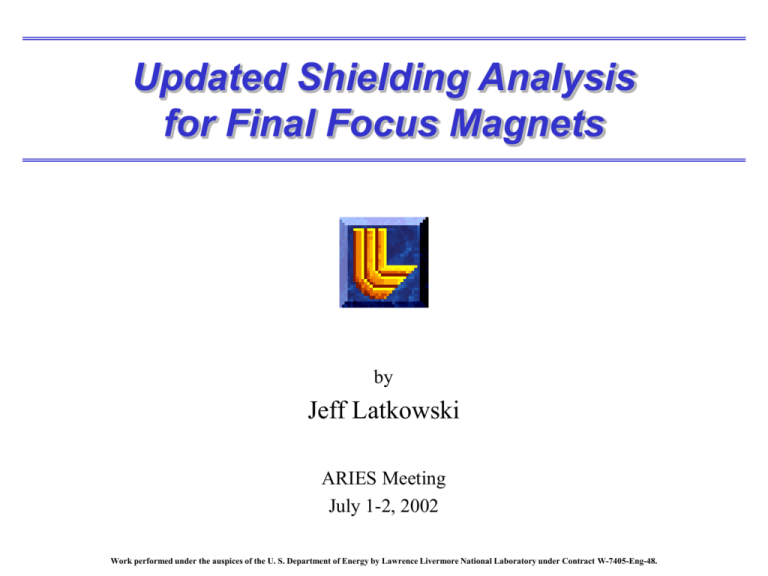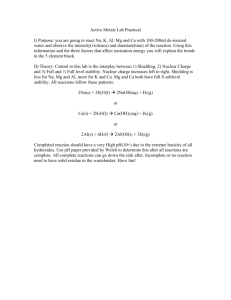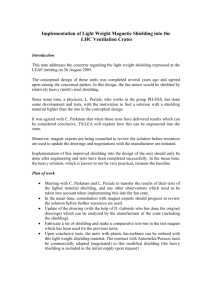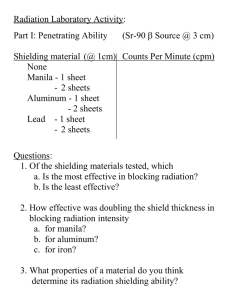ppt
advertisement

Updated Shielding Analysis for Final Focus Magnets by Jeff Latkowski ARIES Meeting July 1-2, 2002 Work performed under the auspices of the U. S. Department of Energy by Lawrence Livermore National Laboratory under Contract W-7405-Eng-48. Outline • Overview of the problem: – General requirements – Why is this an issue now? • Review of work from last several years • Update for new point design • Outstanding issues/future work JFL—7/02 ARIES General requirements for the final focusing magnet shielding design • Shielding design consistent with target beam requirements (e.g., half-angle of array <24º) • Magnets don’t quench on a per-shot basis (limits energy deposition to ~100 mJ/cc/shot) • Recirculating power for magnet cooling doesn’t cause unacceptably large economic hit • Magnets have reasonable radiation damage lifetime • Avoid generation of above Class C waste JFL—7/02 ARIES What limits the radiation lifetime of the final focusing magnets? • Total dose to the insulators is limited to 100 MGy (ref. 1); tends to be dominated (90-95%) by contribution from gamma-rays Inorganic insulators that may be usable with high-temperature superconductors (HTS) offer significantly (~103) greater limits (ref. 2) • “Conservative limit” for the fast neutron fluence (En 0.1 MeV) in Nb3Sn superconductor is 1019 n/cm2 (ref. 1): – Room-temperature anneal required after 3 1018 n/cm2 – 70% recovery assumed HTS appear to have fast neutron References: fluence limits that are at least as (1) Sawan and Walstrom good as that for Nb3Sn (ref. 2) (2) Bromberg, ARIES meeting (Jan. 2002) JFL—7/02 ARIES Why is this an issue when Osiris, HIBALL, etc. had no problem? • Previous studies had only 12-20 beams: – Real estate for shielding was relatively cheap – These designs devoted 30-40 cm for shielding inside the bore of each magnet • We now know that the cost of the accelerator pushes the design towards many beams (100+): – – – – Need roughly same size half-angle for the array Available space for shielding falls as 1/Nbeam Effectiveness of shielding goes as exp(-t/l) Increase from 12 100 beams per side results in room for only ~5 cm of shielding per beam – exp[-(40-5)/l] ~ 0.03 for l=10 cm superconductor and insulation exposed to doses & fluences that are higher by >30 JFL—7/02 ARIES Protection of the final focusing magnets has been an active area of research for ~4 years • HIF Symposium results (3/99) showed that magnet lifetimes were only ~ 1 full-power-year—clearly this is not acceptable. • IFSA-99 (9/99) results extended lifetimes to ~3 years, but showed that recirculating power for cooling might be as high as 10% and superconductor activation was a problem. • 14th TOFE (10/00) results included investigation of shielding features and effects such as: “cross-talk,” shielding thickness & composition, beam clearances, focusing length & frontal shielding, “egg-crates,” angle-of-attack to the target, tapered shielding, and 3-D effects. Made significant progress in extending the lifetime to >30 FPY for a selfconsistent design provided by Wayne Meier’s IBEAM code. • Recently, the thick-liquid HIF community has starting putting together a new, self-consistent point design. Several shielding analyses have been completed. JFL—7/02 ARIES We observed a strong peaking of the fast neutron fluence at the center of the array Additional calculations showed that cross-talk is due to scattering between neighboring penetrations (7 effect) rather than scattering between neighboring magnets (only a 30% effect) Annual fast neutron fluence vs. Position in the magnet array Fast neutron fluence (n/cm2-y) Suggested that “cross-talk” between neighboring penetrations was very important 2.50E+19 2.00E+19 1.50E+19 1.00E+19 5.00E+18 0.00E+00 1 2 3 4 3 2 5 6 JFL—7/02 ARIES 1 4 5 6 Cut-away view of the HYLIFE-II chamber shows inner Flibe pocket, first wall and blanket, and array of magnets for 288-beam base case (Mar. 1999). Lifetime ~1.5 years Lifetime ~40 years 72-beam final focus design for HYLIFE-II including composite shielding design, slab jet arrays for protective flibe pocket, and 3-D aspects of chamber/blanket (Oct. 2000). Schematic of a beamline and definition of terms used in magnet shielding calculations 1stwall, blanket, vac. vess. Flibe cross jets Beam profile target JFL—7/02 ARIES Beam-to-flibe clearance Beam-to-structure clearance CL The beam-to-structure clearance is an important parameter • Beam-to-structure clearance reduced from 5 mm to 1 mm: • Beam-to-Flibe clearance held constant at 5 mm • Total dose fell by 2.3; fast fluence fell by 2.2 • Since previous results showed ~2.5 reductions with zero for both clearances, suggests that beam-to-Flibe clearance isn’t very important • Can we generate structures and/or liquids carefully enough to shield within 1 mm of the beamline? Probably with vortices Due to the high-precision that is possible, vortices are an attractive option for beamline shielding JFL—7/02 ARIES Chamber Beam Map design will further 28 Foot / 28 Main stress the shielding requirements (Same Both Sides) Accelerator Beampoint Map The new (112 Beams Total) Chamber Beam Map 28 Foot / 28 Main (Same Both Sides) Beam Map • Analyses Accelerator completed in late-2000 (112 Beams Total) used 6 6 array; achieved 40Foot of year lifetime with R. half-angle Pulse (28) 29º L. Foot Pulse(28) R. Foot Pulse (28) • Even though all beam positions are not occupied, new design based upon 9 9 array; half-angle limited to 24º L. Main Pulse R.(28) Main ain e (28) R. Main Pulse (28) Pulse (28) Array Angles: min = 8.5°, Main Pulse Main Pulse Foot Pulse FootUnoccupied Pulse Unoccupied max = 24.7° Array Angles: min = 8.5°, max = 24.7° JFL—7/02 ARIES shielding structure for last magnet set target injection pathway vortex tubes for precision beamline shielding cylindrical crossing flibe jets for gross beamline shielding target location at shot time 1 cm of structure, insulation, and H2O cooling 1 cm of structure, insulation, and LN2 cooling (inside and outside coil) size of beam at front of last magnet alternating layers (1 cm each/5 cm total) of W and a proprietary material (good for neutrons) 3 cm thick coil region (40 vol% each of Cu and Nb3Sn + 20 vol% LHe) 2.3 cm of SS304 for banding/shielding beam profiles target-facing end of last magnet set structure and liquid injection/extraction for vortex tube; liquid stand-off from beam is only 1 mm target-facing end of vortex tube Three cases have been analyzed for the new point design • First case: minimal shielding between vortices: – Insulator lifetime: 1.4 years – Superconductor lifetime: 0.6 years • Second case: took advantage of space between vortices (25 v% each SS, flinabe, Ti-hydride shielding, and void); used alternating layers of high-/low-Z material for inner bore shielding (end point from Oct. 2000): – Insulator lifetime: 24 years – Superconductor lifetime: 9 years • Third case: tweaked inner bore shielding to emphasize neutrons rather than gamma-rays: – Insulator lifetime: 13 years – Superconductor lifetime: 16 years JFL—7/02 ARIES Additional work is needed/planned • Optimization to further increase magnet lifetime • Add beam neutralization hardware, liquid jet nozzles • Need to look at recirculating power for magnet cooling (results already generated but have not been synthesized) • Waste disposal needs drastic improvement: WDRcoil = 29 (94Nb) • Evaluate/improve shielding design for 2nd-to-last & 3rd-tolast magnets; others? bending magnet? • Consider high-temperature superconductors? • Look at life-cycle waste volume vs. shielding design (long life magnets may actually increase overall waste volume) JFL—7/02 ARIES





